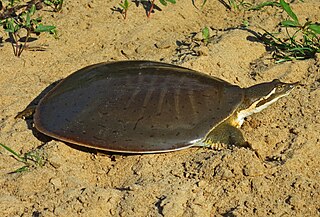
The Trionychidae are a taxonomic family of a number of turtle genera, commonly known as softshell turtles. The family was erected by Leopold Fitzinger in 1826. Softshells include some of the world's largest freshwater turtles, though many can adapt to living in highly brackish areas. Members of this family occur in Africa, Asia, and North America, with extinct species known from Australia. Most species have traditionally been included in the genus Trionyx, but the vast majority have since been moved to other genera. Among these are the North American Apalone softshells that were placed in Trionyx until 1987.

The Kinosternidae are a family of mostly small turtles that includes the mud turtles and musk turtles. The family contains 25 species within four genera, but taxonomic reclassification is an ongoing process, so many sources vary on the exact numbers of species and subspecies. They inhabit slow-moving bodies of water, often with soft, muddy bottoms and abundant vegetation.

The Indian narrow-headed softshell turtle, also known as the small-headed softshell turtle or the Indo-Gangetic softshell turtle, is an endangered species of softshell turtle native to waterways and rivers of the Indian subcontinent. It is very large, feeding on fish, frogs, worms, crustaceans and molluscs, and even the occasional swimming small rodent or other mammal. C. indica, like other softshell turtles, uses it flexible shell to dig itself deep into sandy lake and river bottoms; here, it patiently waits for potential prey to swim by. They will also ambush and chase their prey, depending on availability, the time of year, and size of the prey. In the past it was included as a subspecies of Chitra chitra, a species restricted to Southeast Asia using current taxonomy.

Staurotypus is a genus of aquatic turtles, commonly known as giant musk turtles, Mexican musk turtles, or three-keeled musk turtles, in the family Kinosternidae. The genus contains two recognized species, which are endemic to Mexico and Central America. Both species are sold and bred as pets.

The Chinese softshell turtle is a species of softshell turtle that is native to China and Taiwan, with records of escapees—some of which have established introduced populations—in a wide range of other Asian countries, as well as Spain, Brazil and Hawaii.

Apalone is a genus of turtles in the family Trionychidae. The three species of Apalone are native to freshwater habitats in North America; they are the only living softshell turtles from the Americas.

The narrow-bridged musk turtle is a species of turtle in the family Kinosternidae. The species is found in Central America and Mexico.

The spiny softshell turtle is a species of softshell turtle, one of the largest freshwater turtle species in North America. Both the common name, spiny softshell, and the specific name, spinifera (spine-bearing), refer to the spiny, cone-like projections on the leading edge of the carapace, which are not scutes (scales).

The pallid spiny softshell turtle is a subspecies of spiny softshell turtle native to the U.S. states of Arkansas, Oklahoma, Louisiana and Texas. It was first described by Robert G. Webb in 1962.

The northern spiny softshell turtle is a subspecies of soft-shelled turtle in the family Trionychidae. The subspecies is native to the United States and can be found from Montana at the western edge of its range to Vermont and Quebec on the eastern edge. Introduced populations have also been found in Massachusetts, New Jersey, Arizona, and Virginia.

The Guadalupe spiny softshell turtle is a subspecies of soft-shelled turtle native to the United States, in the state of Texas. Their range is limited only to the Nueces and Guadalupe rivers, and their immediate tributaries.

The Texas spiny softshell turtle is a subspecies of the spiny softshell turtle in the family Trionychidae. The subspecies is native to the southwestern United States and adjacent northeastern Mexico.

The Florida softshell turtle is a species of turtle in the family Trionychidae. The species is native to the Southeastern United States.
Norman Edouard "Kibe" Hartweg was an American herpetologist, Curator of Herpetology for the Museum of Zoology at the University of Michigan, and president of the American Society of Ichthyologists and Herpetologists. He was a specialist in the taxonomy and distribution of turtles, and is honored by having a subspecies of turtle named after him: the western spiny softshell turtle, Apalone spinifera hartwegi. He is also credited with having described several new species, including the Big Bend slider, Trachemys gaigeae, the Oaxacan patchnose snake, Salvadora intermedia, and Dunn's hognose pit viper, Porthidium dunni.

The Asiatic softshell turtle or black-rayed softshell turtle is a species of softshell turtle in the Trionychidae family. Despite its name, it is not the only softshell turtle in Asia.

The Cuatro Ciénegas softshell, also called the black spiny softshell, is a subspecies of the spiny softshell turtle in the family Trionychidae. It is found only in the Cuatro Ciénegas Basin in the Mexican state of Coahuila and it is considered critically endangered by the IUCN. The subspecies, along with its parent species, was formerly classified in the genus Trionyx.

The giant musk turtle, also known commonly as the Chiapas giant musk turtle or the Mexican giant musk turtle, is a species of turtle in the family Kinosternidae. The species is found in Central America.

The Mexican musk turtle, also known commonly as the giant musk turtle, is a species of turtle in the family Kinosternidae. The species occurs in Central America and Mexico.

The smooth softshell turtle is a species of softshell turtle of the family Trionychidae. This freshwater turtle is endemic to the United States where it inhabits the Mississippi River system and other river basins emptying into the Gulf of Mexico.

















